|
The Identity of Le Serpent Rouge
Re-Membering the Hidden Geography of the Alchemical Marriage
by Simon Miles
from
ConsciousEvolution Website
recovered through
WayBackMachine Website

The "Red Sea" in the caption (right) this detail from the
Ripley Scroll was a well-known
code name for the divine mercurial water and its tincturing
power. Here it is depicted as the blood pouring from the heart
of the "Serpent of Arabia". It brings happiness to whomsoever
finds it, and flows, round as a ball, to every place in the
world, Ripley writes.
-from The Hermetic Museum: Alchemy and Mysticism by
Alexander Roob (Taschen 1997)
In 1967 a roughly printed booklet of
five typewritten sheets was deposited in the French Bibliotèque
Nationale, as is legally required of every document published in
France. It bore the title: Le Serpent Rouge: Notes sur Saint Germain
Des Pres et Saint Sulpice de Paris, and was bound together with some
rough maps of France and some genealogies. The main body of the text
comprises a prose-poem, of thirteen short paragraphs. It is written
in French in a cryptic style filled with obscure and esoteric
references.
Little about the poem makes sense, from its appearance and origin,
to the identity of its authors, to its content itself. It is
generally accepted that the poem has some connection to the
mysteries of Rennes-le-Château, although, as we shall see, even this
assumption is not as clear-cut as might be supposed.
A link to the poem itself may be found at
Marcus Williamson and
Corella Hughes Le Serpent Rouge webpage at their comprehensive
Rennes-le-Château Homepage. various alternative translations of the
poem from its original French into English and Italian, and a
detailed analysis of the text and its abundant hermetic, alchemical
and rosicrucian metaphors.
The events surrounding the appearance of Le Serpent Rouge (hereafter
LSR) are described in detail in the book
The Holy Blood and the Holy
Grail by Lincoln, Baigent and Leigh. This includes an account of the
mystery of the identity and fate of the "authors" of LSR, or at
least, those named on it’s title page, all three of whom apparently
died in mysterious circumstances shortly after the claimed date of
publication. However, for a recent alternative analysis of this
version of events read this posting at Henry Lincoln’s
Key to the
Sacred Pattern Website Discussion Forum.
Having stated the bare facts of the existence of the poem, we now
put these aspects to one side. For the purpose of the analysis which
follows, only the content of the poem itself will come into
consideration. The story of its provenance and unorthodox publishing
might well be ambiguous, but at least the actual content of the work
is not. We will approach the poem therefore assuming nothing except
that it was written in 1967 or earlier, and became public after that
date.
On first encounter, LSR appears to be a nonsense work assembled from
obscure and apparently unconnected esoteric references. If there is
an unambiguous content to the poem, it would seem to elude any kind
of simplistic or surface reading. Perhaps, as some have suggested,
the work is indeed simply gibberish. Yet, one may also glimpse a
semblance of inner logic which hints that it would be rash to jump
too quickly to such a conclusion. Nevertheless, if there is a sense
to be made of it, then one might guess that it requires a key, or
template, by which the sense of it can be grasped and the most
puzzling references identified.
Indeed, several authors have presented attempts at a "decoding" of
Le Serpent Rouge, often of an intensely personal or esoteric nature,
but despite some creative and even quite compelling theories, the
essential puzzle remains: what is it which this curious poem is
describing behind the veil of nonsense and arcane clues? What is the
nature of this journey around the zodiac of thirteen signs? Indeed,
what is le serpent rouge, or, the red snake?
This essay will present an entirely new reading of the poem which
will attempt to provide satisfying if surprising answers to these
questions and others. While it will not attempt to explain all,
indeed most, of the cryptic references the work contains, it will
positively identify two crucial sources of material which the
authors of LSR, whoever they were, employed in constructing the
framework of the poem. It is to be hoped that by positively
illuminating one layer at least of the many-layered mystery of Le
Serpent Rouge, other aspects of meaning of the poem will begin to
come into clearer view.
One of these sources is a book which will be shown to have been a
rich source of the background material and symbolic content which
makes up the architecture of LSR. It will be shown to be an almost
inescapable conclusion that whoever was responsible for creating LSR
was familiar with this book. Further, once the book and its contents
have been positively identified, the specifics of this content will
enable us to reveal and confirm the identity of Le Serpent Rouge
itself.
The second source is an original map form which may be familiar to
some readers of these pages. This unique map will provide the clues
as to the nature of the journey undertaken in the poem, and a
spatial and geographic context within which many of the otherwise
puzzling references in the poem begin to make sense. Whilst this
particular map has no claims to historical reliability of any kind,
and indeed might be dismissed as a modern construction, which in a
sense it is, it is also demonstrably the core spatial metaphor which
underpins the action of LSR. This leads to inevitable questions
about the origin of both the map and of the poem, for
the connection can be shown to be so compelling that either the map
was known to the authors, or both map and poem have emerged
full-blown from the collective unconscious as mutually reinforcing templates revealing
the same hidden esoteric geography of Europe.
This is to get ahead of the argument however. To arrive at these
conclusions, it will be necessary to describe the poem, together
with the two sources, the book and the map, individually, and in
relation to each other. As a beacon to keep on track through the
tangled trails of this material, we will hold as our initial goal,
at least, the answer to the specific question: who or what is Le
Serpent Rouge as described in the poem. To understand the identity
of this "red snake" which was the object of the journey undertaken
by the protagonist of the poem, we will first examine the nature of
the journey itself. Once the path taken is clear, the destination
will become visible.
The hero, referred to only as Cet Ami, or This Friend, undertakes a
journey around a zodiac, with certain unusual features. It has
thirteen signs, including the usual twelve with the addition of Ophiucus, the
Serpent-Holder. It begins in Aquarius and ends in
Capricorn, rather than in Aries and Pisces as is traditional.
Besides these small variations, it is clearly not a zodiac in the
sky, amongst the stars, where the zodiac is usually to be found,
through which our Friend is journeying. as his travelstake him
through "woods" and "hills" and "mountains", it would seem that this
zodiac is somehow located on the earth. If the journey is not
through some literal geographical region, then at least it is a
passage through a metaphorical landscape.
Keeping in mind that we are seeking to identify the nature and
location of this zodiac which provides the stage for the action of
the poem, we look for other clues within the work which might help
to shed light on the overall framework.
A prominent clue to unravelling this puzzle is presented on the
second page of the original pamphlet in which the poem itself
appears. This page is presented as a kind of frontispiece. It
depicts a rough sketch of a woman leaning on a column and staring at
four cubes on the ground in front of her. Appearing below the
picture are the words:
... DECOUVRIR UNE A UNE LES
SIOXANTE QUATRE PIERRES...
(translation: ...find, one by one, the sixty-four stones...)
Further hints to understanding the inner
geography of LSR are provided within the contents of the poem
itself. In the sequence of Taurus, Gemini and Cancer, we find the
following statements:
-
Taurus: "I can find the 64
scattered stones of the perfect cube."
-
Gemini: "Reassemble the
scattered stones and working with square and compass, put
them back in order."
-
Cancer: "The Mosaic Tiles of the
sacred place alternate black and white."
The clear impression made by these clues
is that this space is created of 64 black and white cubes; that
these had once made up a larger 4 x 4 x 4 cube, but that they are
now to be reassembled into an 8 x 8 chessboard arrangement.
Throughout the poem there are constant references to white and black
in the different signs, and to chess-terms ("the knight’s tour)
which reinforce this conclusion.
It would seem clear then that the action of Le Serpent Rouge
takes
place on a chessboard. If we take this at face value, then we will
now need to find a chessboard which functions as a metaphorical
landscape in some sense, and which also acts as a zodiac. This
immediately presents one major difficulty. If this chessboard is
also a zodiac, in this case one consisting of 13 signs, it appears
at first glance that there is no obvious way to arrange the signs on
the board so that they make sense. Twelve signs would fit nicely
around the twelve outer squares of a 4 x 4 block, but the inclusion
of Ophiucus appears to have created an impasse, as thirteen just
won’t fit.
Nevertheless, if there is a coherent framework to the poem, there
seems little alternative but to imagine it as a 13 sign zodiac
connected in some way to a chessboard in a landscape.
A possible way forward from this impasse is suggested in the 1997
edition of the Guinness Book of Answers. The following sentence
appears in a short description of the zodiac:
"Ophiucus is considered by European
astrologers to be not so much the 13th sign as the second half
of the sign of Scorpio."
With this in mind, it is time to
consider a candidate for the land-based zodiac chessboard on which
LSR might be based.
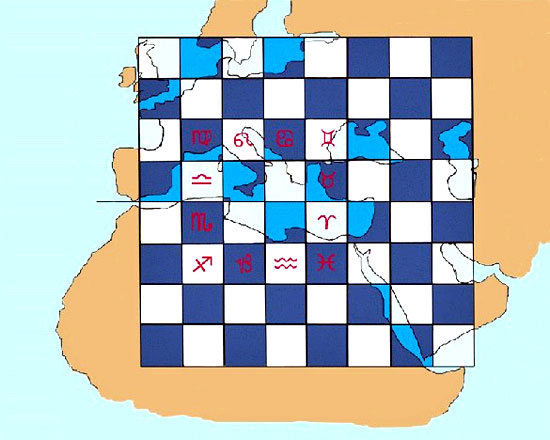
I have described the Chessboard of
Europe elsewhere on this site. It is derived by combining together
the ideas of two researchers in very different fields who wrote
nearly a century apart, unaware of each others works.
The first of these writers was J. Ralston Skinner, author of
The
Source of Measures, published 1875. In that fascinating work, he
discusses at length a square arrangement, the "preferred ancient
form", of the zodiac. It consists simply of the usual twelve signs
disposed around the outer squares of a 4 x 4 matrix, arranged so
that Taurus/Aries occupy the right centre positions, and
Libra/Scorpio the centre left.
The second of the sources was Professor Livio Stecchini, who
describes a grid map in use by the Ancient Egyptians. In Part One, I
describe how Rennes-le-Chateau and Paris both fall on major grid
intersection points of this mapping system. Stecchini’s grid map of
Ancient Egypt gives rise very naturally to an eight-by-eight grid of
squares which neatly encompasses "Greater Europe".
Intuitively, it seemed an interesting idea to explore what would
happen if Skinners "preferred ancient form" was overlaid on the
squares of the Stecchini gridmap. The result is the map-form shown
above.
There are several correspondences between the zodiac signs and the
underlying geographical regions which invite closer scrutiny. It is
noteworthy that Taurus, for example, overlays the country of
Turkey,
and that the major mountain range forming the backbone of this area
is the Taurus Mountains!
The sign of Virgo coincides with that region of Europe,
centered on
south-eastern France, in which the highest concentration of
Black
Madonna statues have been found. These mysterious and ancient images
predate Christianity, and may be traced as references to Isis, who
is also the Woman depicted in the constellation of Virgo, for
example at
Denderah... There is a seamless identity of archetype
which links the two Marys of the Christ story (His Mother and the
Magdalene) to Isis and Virgo.
But I will try to zero in on the two major questions which are
presented by LSR, and present some unexpected but hopefully
satisfying answers. It seems to me that any successful explanation
of LSR must explain, firstly, the nature of the journey undertaken
around this strange zodiac of 13 signs, and secondly, it must
identify exactly who or what is Le Serpent Rouge, or the Red
Serpent.
The only prerequisite I ask of those who wish to follow my argument
is that you put aside, for now at least, all preconceptions about
LSR and what it could mean. I assume nothing at all about the poem,
except for the fact that it exists. I approach it as a piece of text
of unknown origin or purpose, and attempt to make sense of it.
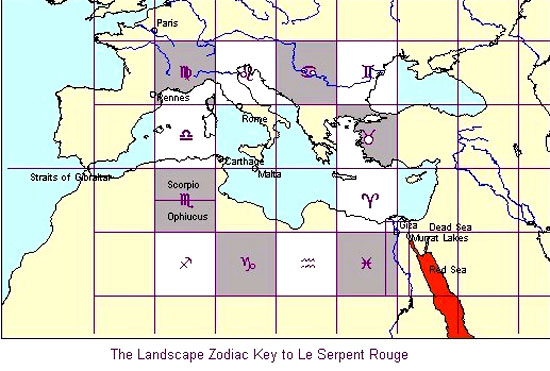
The text (original, facsimile and
translations) may be found at
Marcus Williamsons Rennes report.
The action of the poem consists in a journey by an unnamed
protagonist around a zodiac of 13 signs. Where is this zodiac? How
is it defined? Let us begin with Gunnar’s quote:
The translation of the French line
may be rendered:
...reassemble one by one
the 64 stones....
I take it that the 64 stones make up a
chessboard. References in the poem to black and white squares would
seem to confirm this. Take this as an assumption for now: the action
concerns a chessboard. What kind of a chessboard has a zodiac on it?
The only one I have ever heard of is my Chessboard of Europe
concept. Perhaps this is itself a "private cipher", but stick with
me for now. But if this is so, how could 13 signs be arranged on a
chessboard. Try it. There’s no way to fit them into any kind of
sensible circuit.
One day I was idly flipping through the 1997 Guinness Book of
Answers. I came across a reference to the zodiac which included the
sign of Ophiucus, the Serpent Holder. There I read:
"this sign is
considered by European astrologers to be not so much the 13th sign
as the second half of the sign of Scorpio".
That was just what I needed. So, take Scorpio, and split it into two
halves to create Ophiucus. Now, we have thirteen zodiac signs
arranged on a chessboard.
Let’s check how it fits so far. The poem begins in Aquarius, which
is odd, as zodiacs usually begin with Aries. But check it out:
Aquarius is at the bottom on the right of the centre dividing line
which represents winter. Hence the action starts here at the winter
solstice of this Chessboard of Europe (which recall represents the
precessional transition from the Age of Taurus to Aries).
The references to white and black seem to match up correctly for the
most part. The keen reader can check this out. There are plenty of
other details to observe, but in our haste to get to the main
questions, we skip these, and proceed to the sign of Sagittarius.
Here the poem says: turning again to the east...
Now, this line provide confirmation that indeed this configuration
is correct, because in no other arrangement could one arrive at
Sagittarius and then "turn to the east" to keep going. So we are
looking good.
But now the poem says words to the effect that ahead of me I could
see Le Serpent Rouge. So, stand on the Chessboard of Europe, look to
the east, and what is it that one sees "straight ahead". Why, its
the Red Sea. The Red Sea is the Red Serpent. Now take a close and
careful look at this picture:
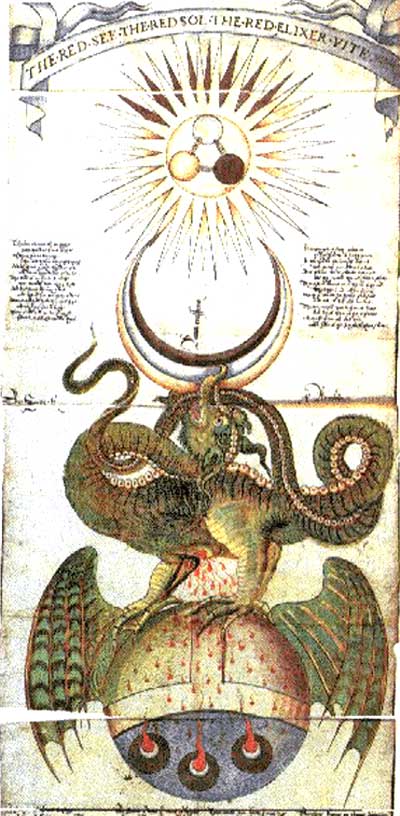
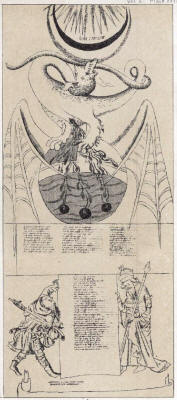
click images to
enlarge
It sounds unlikely, I know, that Le
Serpent Rouge could represent the Red Sea, and so far, the evidence
appears slim. We will need better than that if the identity of LSR
is to be positively confirmed. Nevertheless, I repeat my request to
put aside all preconceptions about the solution at least for now.
Lets go back to Sagittarius. It says, and I quote:
"...l’enorme SERPENT ROUGE, cite
dans les parchemins, salee et amere...".
The translation in
Genisis of this line reads:
"...the enormous RED SERPENT,
mentioned in the documents, rigid and bitter..."
Other translations however render the
last words "salty and bitter".
I prefer the latter translation, but, either way, it seems to make
little sense. Why should the Red Serpent, or indeed the Red Sea, be
considered "rigid and bitter", or "salty and bitter".
Here’s why: the two bodies of water which drain into the Red Sea are
the Dead Sea and the Murrah Lakes (Murrah-Al-Kubra - Egypt). As every schoolchild
knows, the Dead Sea is the saltiest body of water on earth.
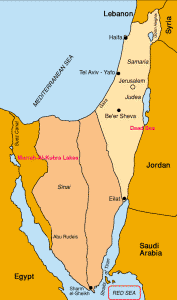
And as
for the Murrah Lakes: this word Murrah simply means Bitter. These
are the Bitter Lakes.
Salty and bitter = Dead Sea and
Murrah Lakes.
So now, not only do we have the Red Sea
in the correct position to correspond to the sighting of le Serpent
Rouge from Sagittarius, but it is specifically identified with just
those two bodies of water which are connected to it!!!!!!!
In other words, this hypothesis makes sense of the "salty and
bitter" quotation.
Perhaps we are onto something here. Could it be that Le Serpent
Rouge is describing a journey around the esoteric geography of the Meditteranean?
Thus far I have advanced the hypothesis that Le Serpent Rouge is a
cipher for the Red Sea, and that the key to this decoding is the
Chessboard of Europe, based upon Professor Livio Stecchini’s
reconstruction of the grid map of the Ancient Egyptians.
However, one might object that this is little more than a lucky
strike. After all, the Chessboard/Zodiac of Europe has not been
publicly described before, and it would seem extremely unlikely that
the authors of LSR could have been aware of it. In fact, one might
even say that it is little more than a fantasy or conceit of mine,
and could not possibly relate to a poem which appeared over 30 years
ago. And this would be a fair comment as things stand.
To make a convincing case that LSR really does describe a kind of
symbolic Grand Tour around the Mediterranean Sea would require
identification of a published source which makes these connections
and was available before the poems appearance.
That’s where Jung comes in. His final work, published just before
his death, was titled: Mysterium Coniunctionis: An Inquiry into the
Separation and Synthesis of Psychic Opposites in Alchemy. It was
first published in German in 1955, and subsequently translated into
English and made available under the Bollingen Series imprint,
Princeton University Press, in 1963. Le Serpent Rouge, for
comparison, appeared in 1967.
This opus was the crowning achievement of Jung's career, a massive
tome summarizing the fruits of a life’s research into the
psychological underpinnings of the alchemical process. Again, it is
not even remotely possible to summarize the contents or themes of
the book here, and so, again, at the risk of skipping over important
details, I will cut straight to the chase.
Section III The Personification of the Opposites contains 5
sub-sections, the last of which is entitled Sal, or Salt. It
consists of 8 chapters. Here are the chapter headings:
a. Salt as the Arcane
Substance
b. The Bitterness
c. The Red Sea
d. The Fourth of the Three
e. Ascent and Descent
f. The Journey through the Planetary Houses
g. The Regeneration in Sea-Water
h. The Interpretation and Meaning of Salt
If anyone will read LSR, and then
examine my hypothesis of the Chessboard/Zodiac of Europe as template
for the action of the poem with its identification of the Red Sea,
and then read these 8 chapters of Jung under the heading of
Sal:
then, I suggest that it will be almost impossible to resist the
conclusion that the authors of LSR had previously read this same
material, and that furthermore, they must have had the
correspondences in mind which the Chessboard scheme brings to light.
One can see immediately just in the chapter headings themselves that
the Red Sea is discussed together with the concepts of salt and
bitterness, just as is the case in LSR. This alone is enough to make
a compelling argument.
Not only does Jung describe at length the symbolic connections
between the Red Sea and the concepts of salt and bitterness, (which
reflect, as I have noted, a geographical reality as well as a
metaphoric one), but he also expands on the link between the Red Sea
and the symbol of the serpent in alchemical thought.
For example, the following quotation appears on page 201:
“I have gone into this Hippolytus
text at some length because the Red Sea was of special
significance to the alchemists. …(It) appears in a very peculiar
manner in the “Tractatus Aristotelis ad Alexandrum Magnum” where
a recipe says:
‘Take the serpent and place it
in the chariot with four wheels and let it be turned around
on the earth. … and then you have placed the four wheels
upon the chariot, and will obtain the result, if you will
advance to the Red Sea, running without running, advancing
without motion’
This curious text requires a little
elucidation. The serpent is the prima material… The four-fold
rotation of the natures corresponds to the ancient tetrameria of
the opus (its division into four parts), i.e. transformation
through the four elements, from earth to fire.”
There is plenty more in this vein, but
perhaps that is enough to show briefly that Jung treats with
considerable detail the connection between the Red Sea, salty and
bitter, the serpent and the alchemical process.
This material could, and hopefully will be, expanded into a much
longer treatment, and this very brief account here will necessarily
be short on detail. However, it should be sufficient to allow the
keen reader to examine the texts for themselves to get the flavor of
what I am suggesting, and to make the case that the LSR authors were
familiar with MC.
There still remains the matter of the nature of the strange journey
undertaken by the protagonist of LSR, a Grand Tour around the
zodiac, which, by my hypothesis, is represented, in this case, in a
square format. So, we are dealing with a square, or four-fold
metaphorical voyage around the “world”, or at least Asia, Europe and
Africa. Is there any precedent for such an idea?
In fact there is, and amazingly enough it is to be found described
in great detail in MC, in the section entitled The Fourth of the
Three, appearing directly after the chapter called The Red Sea.
It remains to identify the precedent for the mysterious journey
which makes up the structure of the narrative of LSR.
The source is a work by the seventeenth century alchemist and
Rosicrucian, Michael Maier, specifically Book 12 of Maier’s
Symbola
aureæ mensæ duodecim nationum , published in Frankfurt, 1617. The
section of interest is entitled:
“A Subtle Allegory, concerning the
Secrets of Alchemy, very useful to possess and pleasant to
read.”
A link to this document is provided
here:
Michael Maier - A Subtle Allegory: The Fourfold world journey,
or Grand Peregrination, through the Planetary Houses.
Within this “Subtle Allegory” is found an account of a symbolic
world-journey undertaken by the alchemist in his imagination. Jung
treats of this journey at great length in the sections of MC
concerned with the Red Sea. In fact, the opening sentence of the
fourth chapter (“The Fourth of the Three”) of the Third Section
(“Sal”) of MC reads as follows:
“In the course of his mystic
peregrination Maier reaches the Red (“Erythraen”) Sea, and in
the following way: he journeyed to the four directions, to the
north (Europe), to the west … , to the east, …and turning
south…”
Then follows an extended analysis and
discussion of the symbolism of this “mystic peregrination”, a phrase
which reminds me of the opening words of LSR in Aquarius:
“Comme ils sont estranges les
manuscripts de cet Ami, grand voyageur de l’inconnu (How strange
are the manuscripts of this friend, great traveler of the
unknown)”.
That’s it then. Michael Maier’s
four-fold world journey to the Red Sea appears in Jung’s
Mysterium
Coniunctionis. And then, the very same themes which Jung enlarges
upon in the course of this discussion appear as the core motifs of
Le Serpent Rouge.
A close examination of these works will convince, imho, even the
most skeptical reader that something is, indeed, going on here.
In the light of this, matters take an intriguing turn. Because, if
it is accepted that Jung/Maier provides the precedent for LSR, then
how could it be that the crucial identification of the Red Serpent
with the Red Sea, as part of a unique geographic/zodiacal map-form,
could have been known to the authors of LSR? This would imply that
they were aware of the Chessboard of Europe format.
Or perhaps, post-Gunnar, we are beginning to understand how a cipher
can become embedded in a text without the authors of that text being
conscious of it’s presence!
In any case, putting the three items (LSR, MC and the
Chessboard of
Europe) together, seems to provide some extraordinary correlations,
and the conclusion that this must be more than co-incidence seems,
to me at least, irresistible.
The biggest problem with accepting the scheme I have outlined, I
suppose, is that everybody "knows" that LSR concerns the
environs
around Rennes. The zodiac is understood to be laid out in the
surrounding countryside, although no-one has definitely identified
it (though many have tried), nor can anyone point to a definitive
statement which proves that, indeed, LSR is all about a local tour
of Rennes.
The original LSR publication does not make this claim, but it seems
to have become folklore, due perhaps to Boudet’s book, that the
"correct" solution must involve something near Rennes, or at least
around it.
In fact, this intuitive idea is correct: the Tour of LSR is "around"
Rennes. The tricky aspect which has kept the solution hidden is that
the scale is vastly different from what has been imagined...
What do I mean? Well, Rennes is located on the grid map of Europe.
It lies on the meridian which defines the left, or west side of the
Zodiac of Europe, as described on my site.
Hence the Tour does involve Rennes, and follows a circuit which
includes Rennes, but it is on a continent-wide scale, rather than a
local scale! The circuit takes in Rennes, but goes all the way
around the Mediterranean Sea!!!
"Prove it!", I hear the cry go up...
Turn to Ophiucus. The original text of
the last sentence reads as follows:
"A ceci, Ami Lecteur, garde-toi
d’ajouter ou de retrancher un iota...medite, Medite encore, le
vil plomb de mon ecrit contient peut-etre l’or plus pur"
which translates as:
"Take heed, my Friend, do not add or take away one iota. Think
and think again, the base lead of my words may contain the
purest gold."
I understand "do not add or take away
one iota" to imply that we should pay very careful attention to the
most minute aspect of this document. The very next words are "medite,
Medite encore". The second "medite" is capitalized in the original.
Grammatically, it should not be, unless it was a proper noun.
Should we understand this to be a mere typographical error? Or as it
follows directly on from the exhortation to pay attention, and in
particular not to take away the smallest detail, would we rather be
justified in assuming that this capitalization is of importance? I
choose the latter.
Is there a proper noun Medite? Not that I am aware of. Unless it is
short for something... How about Mediterranean?
|





